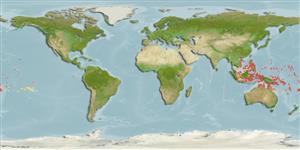>
Atheriniformes (Silversides) >
Atherinidae (Silversides) > Atherinomorinae
Etymology: Stenatherina: Greek, stenos =narrow + Greek, atherina, the Greek name for the eperlane; 1770 (Ref. 45335).
More on authors: Jordan & Richardson.
Environment: milieu / climate zone / depth range / distribution range
Écologie
marin récifal; profondeur 1 - 20 m (Ref. 86942). Tropical; 19°N - 20°S
Pacific Ocean: Sumatra and the northern Cook Islands, north to the Philippines, Caroline Islands, and Marshall Islands, south to Fiji.
Taille / Poids / Âge
Maturity: Lm ? range ? - ? cm
Max length : 11.0 cm TL mâle / non sexé; (Ref. 9760)
Description synthétique
Clés d'identification | Morphologie | Morphométrie
Épines dorsales (Total) : 5 - 8; Rayons mous dorsaux (Total) : 8 - 10; Épines anales: 1; Rayons mous anaux: 9 - 12. Vomerine teeth forming a characteristic T pattern. Ascending process of premaxilla long, extending past orbit into interorbital space; lateral process very long and pungent. Gill rakers long and slender, longer than half the diameter of pupil. Interdorsal scales 8-10. Distinct crescentic mark present on snout immediately in front of eye; upper part of midlateral band terminating as half crescent on upper lobe of caudal fin.
Preferred habitat appears to be deeper enclosed atoll lagoons, reefs, coastal waters and harbors. May gather in schools at night when attracted to light but generally not found in very large numbers. May be taken as food by larger commercial species (Ref. 9760).
Life cycle and mating behavior
Maturities | Reproduction | Spawnings | Egg(s) | Fecundities | Larves
Oviparous, distinct pairing during breeding (Ref. 205).
Myers, R.F., 1991. Micronesian reef fishes. Second Ed. Coral Graphics, Barrigada, Guam. 298 p. (Ref. 1602)
Statut dans la liste rouge de l'IUCN (Ref. 130435)
Menace pour l'homme
Harmless
Utilisations par l'homme
Pêcheries: intérêt commercial mineur; appât: occasionally
Outils
Articles particuliers
Télécharger en XML
Sources Internet
Estimates based on models
Preferred temperature (Ref.
123201): 26.7 - 29.3, mean 28.7 °C (based on 1304 cells).
Phylogenetic diversity index (Ref.
82804): PD
50 = 1.0000 [Uniqueness, from 0.5 = low to 2.0 = high].
Bayesian length-weight: a=0.00562 (0.00244 - 0.01296), b=3.11 (2.91 - 3.31), in cm total length, based on LWR estimates for this (Sub)family-body shape (Ref.
93245).
Niveau trophique (Ref.
69278): 3.3 ±0.4 se; based on size and trophs of closest relatives
Résilience (Ref.
120179): Haut, temps minimum de doublement de population inférieur à 15 mois (Preliminary K or Fecundity.).
Fishing Vulnerability (Ref.
59153): Low vulnerability (10 of 100).
Nutrients (Ref.
124155): Calcium = 109 [59, 211] mg/100g; Iron = 0.693 [0.404, 1.257] mg/100g; Protein = 19.4 [17.1, 21.8] %; Omega3 = 0.14 [0.06, 0.36] g/100g; Selenium = 21.7 [10.3, 49.4] μg/100g; VitaminA = 181 [57, 527] μg/100g; Zinc = 1.82 [1.23, 2.59] mg/100g (wet weight);
